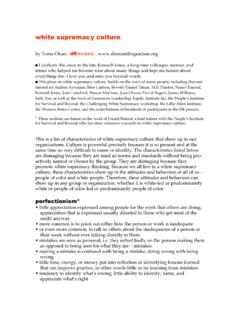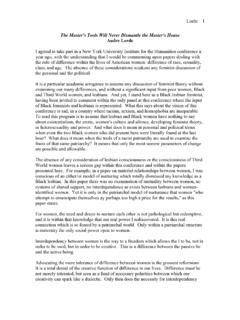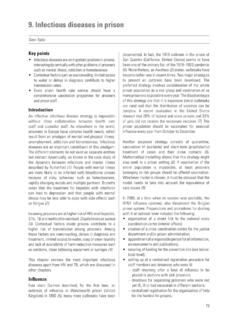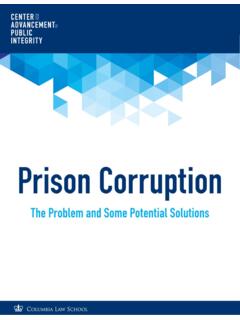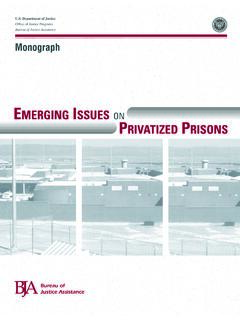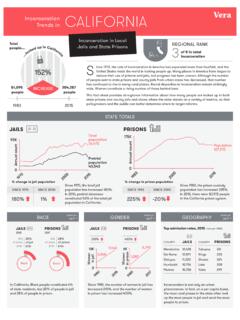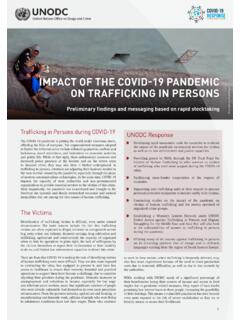Transcription of © 2003 by Angela Y. Davis - collective liberation
1 2003 by Angela Y. DavisOpen Media series editor, Greg rights reserved No part of this book may be reproduced, stored in a retrieval system, or transmitted in any form, by any means, includ ing mechanical, electric, photocopying, recording or otherwise, with out the prior written permission of the Canada: Publishers Group Canada, 250A Carlton Street, Toronto, ON M5A 2L1In the ; Turnaround Publisher Services Ltd., Unit 3/ Olympia Trading Estate, Coburg Road, Wood Green, London N22 6 TZIn Australia: Palgrave Macmillan, 627 Chapel Street, South Yarra, VIC 3141 Cover design and photos: Greg Ruggiero ISBN-10: 1-58322-581-1 / ISBN-13: 978-1-58322-581-3 Printed in 8 7 6 5 4 3 ContentsAcknowledgments.
2 *..7 CHAPTER IIntroduction prison Reform or prison Abolition? . ,..9 CHAPTER 2 Slavery, Civil Rights, and AbolitionistPerspectives Toward 3 Imprisonment and 40 CHAPTER 4 How Gender Structures the prison 5 The prison Industrial Complex ..84 CHAPTER 6 Abolitionist 116 Notes ..119 About the should not be listed as the sole author of this book, for its ideas reflect various forms of collaboration over the last six years with activists, scholars, prisoners, and cultural work ers who have tried to reveal and contest the impact of the prison industrial complex on the lives of people within and outside prisons throughout the world .
3 The organizing committee for the 1998 Berkeley conference, Critical Resistance: Beyond the prison Industrial Complex, included Bo (rita d. brown), Ellen Barry, Jennifer Beach, Rose Braz, Julie Browne, Cynthia Chandler, Kamari Clarke, Leslie DiBenedetto Skopek, Gita Drury, Rayne Galbraith, Ruthie Gilmore, Naneen Karraker, Terry Kupers, Rachel Lederman, Joyce Miller, Dorsey Nunn, Dylan Rodriguez, Eli Rosenblatt, Jane Segal, Cassandra Shaylor, Andrea Smith, Nancy Stoller, Julia Sudbury, Robin Templeton, and Suran Thrift. In the long process of coordinating plans for this con ference, which attracted over three thousand people, we worked through a number of the questions that I raise in this book.
4 I thank the members of that committee, including those who used the conference as a foundation to build the organization Critical Resistance. In 2000, I was a member of a University of California Humanities Research Institute Resident Research Group and had the opportunity to partic ipate in regular discussions on many of these issues. I thank the members of the group Gina Dent, Ruth Gilmore, Avery Gordon, David Goldberg, Nancy Schepper Hughes, and Sandy Barringer for their invaluable insights. Cassandra Shay lor and I coauthored a report to the 2001 world Conference Against Racism on women of color and the prison industrial complex a number of whose ideas have made their way into this book.
5 I have also drawn from a number of other recent articles I have published in various collections. Over the last five years Gina Dent and I have made numerous presentations together, published together, and engaged in protracted conversations on what it means to do scholarly and activist work that can encourage us all to imagine a world without prisons. I thank her for reading the manuscript and I am deeply appreciative of her intellectual and emotional support. Finally, I thank Greg Ruggiero, the editor of this series, for his patience and Reform or prison Abolition?
6 In most parts of the world , it is taken for granted that who ever is convicted of a serious crime will be sent to prison . In some countries including the United States where capital punishment has not yet been abolished, a small but signifi cant number of people are sentenced to death for what are considered especially grave crimes. Many people are familiar with the campaign to abolish the death penalty. In fact, it has already been abolished in most countries. Even the staunchest advocates of capital punishment acknowledge the fact that the death penalty faces serious challenges.
7 Few peo ple find life without the death penalty difficult to the other hand, the prison is considered an inevitable and permanent feature of our social lives. Most people are quite surprised to hear that the prison abolition movement also has a long history one that dates back to the historical appearance of the prison as the main form of punishment. In fact, the most natural reaction is to assume that prison activists even those who consciously refer to themselves as "antiprison activists" are simply trying to ameliorate prison conditions or perhaps to reform the prison in more fundamental ways.
8 In most circles prison abolition is simply unthinkable and implausible. prison abolitionists are dis-missed as Utopians and idealists whose ideas are at best unre alistic and impracticable, and, at worst, mystifying and fool ish. This is a measure of how difficult it is to envision a social order that does not rely on the threat of sequestering people in dreadful places designed to separate them from their communities and families. The prison is considered so "natural" that it is extremely hard to imagine life without is my hope that this book will encourage readers to question their own assumptions about the prison .
9 Many peo ple have already reached the conclusion that the death penal ty is an outmoded form of punishment that violates basic principles of human rights. It is time, I believe, to encourage similar conversations about the prison . During my own career as an antiprison activist I have seen the population of prisons increase with such rapidity that many people in black, Latino, and Native American communities now have a far greater chance of going to prison than of getting a decent education. When many young people decide to join the mili tary service in order to avoid the inevitability of a stint in prison , it should cause us to wonder whether we should not try to introduce better question of whether the prison has become an obso lete institution has become especially urgent in light of the fact that more than two million people (out of a world total of nine million) now inhabit prisons, jails, youth facili ties, and immigrant detention centers.
10 Are we willing to rel egate ever larger numbers of people from racially oppressed communities to an isolated existence marked by authoritari an regimes, violence, disease, and technologies of seclusion that produce severe mental instability? According to a recent study, there may be twice as many people suffering from mental illness who are in jails and prisons than there are in all psychiatric hospitals in the United States | Angela Y. DavisWhen I first became involved in antiprison activism dur ing the late 1960s, I was astounded to learn that there were then close to two hundred thousand people in prison .

